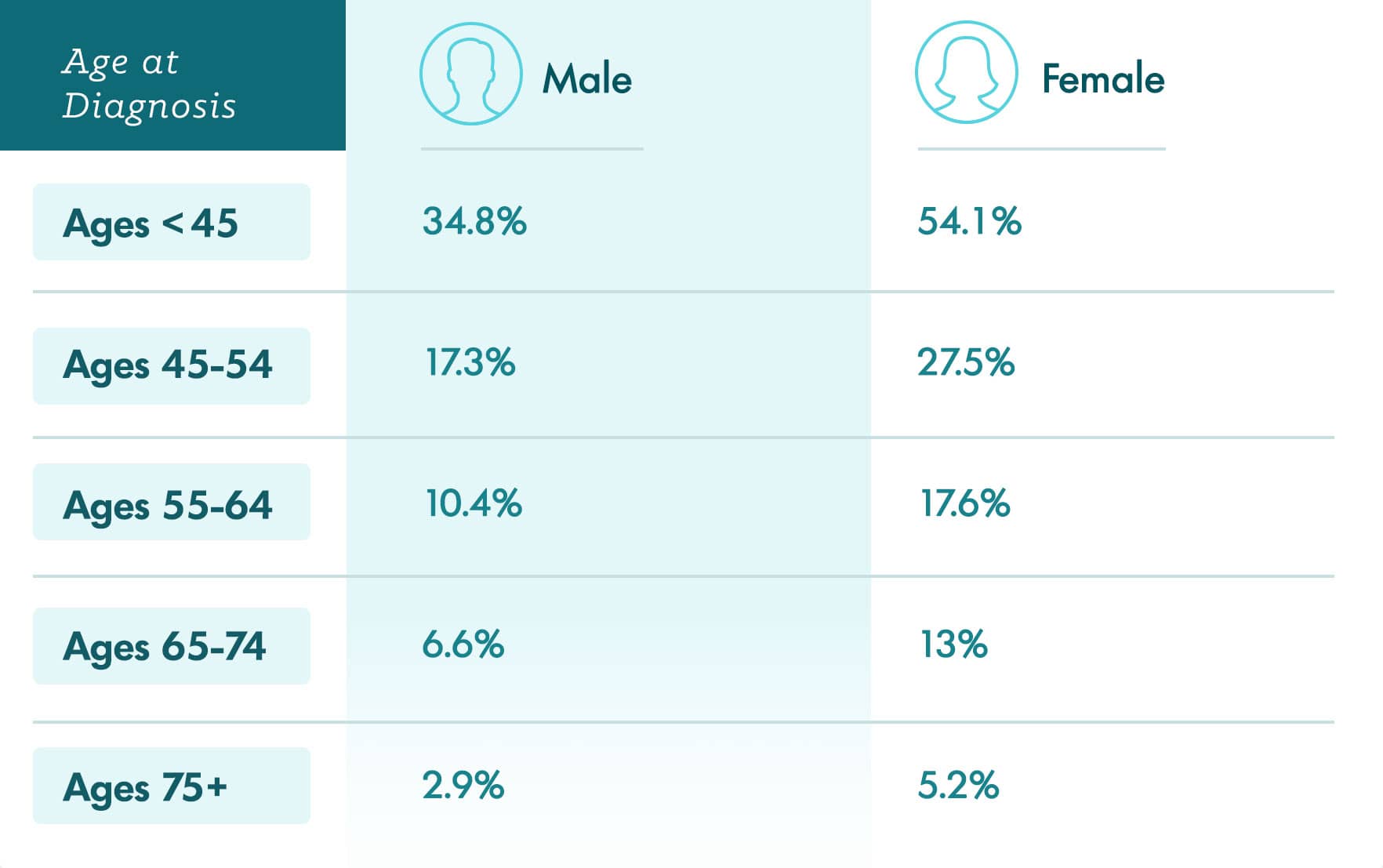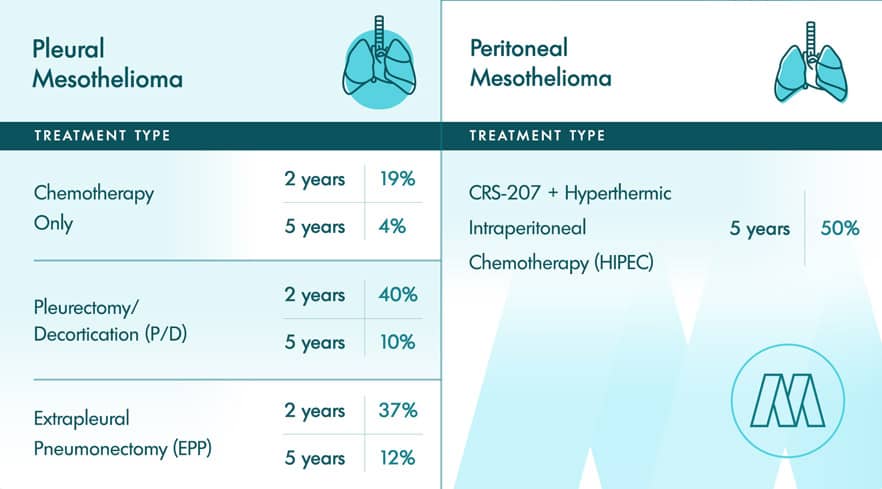Mesothelioma Survival Rates
Mesothelioma survival rates provide patients and loved ones with an idea of how many others survived for a certain length of time when faced with a similar diagnosis.
Key Points
-
1
Mesothelioma survival rates are presented in 1-, 3-, 5- and 10-year increments.
-
2
Patient survival will vary based on cancer type, stage, treatment and other factors.
-
3
Survival statistics can provide patients with an understanding of their potential survival.
-
4
Remission and recurrence are possible for mesothelioma patients.
Cancer survival rates provide an idea of how long patients are likely to survive based on their diagnosis, typically in 5-year increments. For aggressive cancers like malignant mesothelioma that often result in survival of less than five years, 3-year and 1-year survival rates are also usually given. Survival rates differ from mesothelioma prognosis and life expectancy in that they provide percentages based on year intervals, as opposed to information on overall disease progression or a specific estimate of how many years one is expected to live.
Factors Impacting Mesothelioma Survival Rates
Statistics are typically based on large case studies or information from cancer databases, covering a wide population. However, while the numbers represent a majority, they can vary on a case-by-case basis. There are many factors that can impact individual patient survival and cause a deviation from the average survival rate for a given diagnosis.
Mesothelioma Type and Survival
Mesothelioma type is one of the most important factors that mesothelioma specialists use to determine estimated survival. There are four main types of mesothelioma, including pleural, peritoneal, pericardial and testicular mesothelioma, different based on where the cancer originates. Tumor location impacts survival because of what major organs are impacted by the cancer, including nearby organs that may be susceptible to metastasis (spreading).
Cell type can also be an indicator of how likely the cancer is to spread and respond to treatment. Sarcomatoid mesothelioma is generally less responsive to treatment with quickly spreading cells, while epithelioid mesothelioma cases show longer life expectancies. Biphasic mesothelioma contains a mix of both sarcomatoid and epithelioid cells, and cancer progression varies based on which cell type is dominant.
Mesothelioma Staging and Survival
Staging shows how far the cancer has already progressed at diagnosis. Stage 1 and stage 2 diagnoses typically demonstrate higher survival rates than those diagnosed in the later stages, as the cancer has not yet spread to distant organs and lymph nodes. When the mesothelioma cancer is localized, aggressive treatments are more likely to kill the majority of the cancer cells and help prevent metastasis.
In terms of survival rate statistics, the National Cancer Institute maintains a database that tracks survival rates of patients with malignant pleural mesothelioma. Staging is recognized as either local, regional or distant, instead of using four numerical stages. Local means the cancer has not spread, regional indicates that the cancer has spread to nearby tissues and organs, while distant references cancer that has metastasized to distant areas of the body.
Other Factors and Mesothelioma Survival
Other factors, such as patient age, sex, health, blood counts, genetics and history of smoking are less influential in predicting patient survival, but have been proven to affect survival rates. For example, survival rates tend to decline as age increases, and men often face worse survival rates than women.


Abnormalities in blood counts and genetic features have also been seen to influence survival rates. Those with a history of smoking tend to also face shorter lifespans than mesothelioma patients with no history of tobacco use.
Mesothelioma Survival Statistics
Information is limited for mesothelioma since it is a rarer cancer, especially for pericardial and testicular mesothelioma, which are each diagnosed in less than 5% of all recorded cases. Around 3,200 new cases of mesothelioma are diagnosed each year, expanding upon the existing set of data and providing more insight into how the disease progresses and impacts survival.
Survival statistics show that median survival varies based on mesothelioma type or tumor location. Malignant peritoneal mesothelioma demonstrates the best overall survival rate, followed by malignant pleural mesothelioma and malignant pericardial mesothelioma. Since there are so few cases of pericardial mesothelioma, data is limited and survival rates are more challenging to predict.
| Survival Rates by Mesothelioma Type | ||||
|---|---|---|---|---|
| 1-Year | 3-Year | 5-Year | 10-Year | |
| Pleural Mesothelioma | 73% | 23% | 12% | 4.7% |
| Peritoneal Mesothelioma | 92% | 74% | 65% | 39% |
| Pericardial Mesothelioma | 51% | 26% | 23% | N/A |
When studying incidence rates and survival rates of mesothelioma, researchers have sought to better understand why peritoneal mesothelioma is often linked to higher survival rates. Some have identified a potential link between tumor location and the type of occupational exposure.
One study, in particular, found that pleural mesothelioma is more often linked to occupational exposure, negatively impacting survival rates. Peritoneal mesothelioma more often results from non-occupational exposure, which may contribute to better survival rates. Information is lacking for pericardial mesothelioma due to a limited number of cases.
In a study of 380 mesothelioma patients:
- 303 patients were diagnosed with pleural mesothelioma and 77 were diagnosed with peritoneal mesothelioma
- Average survival for pleural patients was 18.4 months and average survival for peritoneal patients was 75.7 months
- 284 patients faced occupational exposure and 96 patients faced non-occupational exposure
- Average survival was 19.7 months for patients with occupational exposure and 53.7 months for patients with non-occupational exposure
Studies continue to find and analyze other connections between patient characteristics and survival rates, such as occupation, length of exposure, age at the time of initial exposure and type of asbestos. Researchers have concluded that patients can help improve their chances of early detection by identifying a history of asbestos exposure and sharing any details regarding time, length and frequency of exposure with their physician.
Treatment and Mesothelioma Survival Rates
Researchers also attribute peritoneal survival rates, and improvements in survival rates overall, to advancements in treatment. Clinical trials continue to explore experimental treatments and different uses of traditional treatments in an effort to extend patient survival and potentially find a cure.
In recent years, peritoneal mesothelioma, in particular, has seen improved treatment methods, as with hyperthermic intraperitoneal chemotherapy (HIPEC) and hyperthermic intraoperative chemotherapy (HIOC). HIPEC involves the application of a heated chemotherapy wash throughout the abdominal region during surgery. HIOC utilizes the same concept, but can be used in other regions of the body and isn’t specific to peritoneal mesothelioma.
Mesothelioma surgeries have also been able to extend the lives of many pleural mesothelioma patients, such as with pleurectomy decortication (P/D) and the EPP. Patients and their loved ones should discuss potential treatment options, including standard and experimental, with their mesothelioma doctor to determine eligibility and an individualized treatment plan.


If new treatments or aggressive plans aren’t possible, cancer patients can still undergo palliative treatment to help manage symptoms and improve quality of life.
Mesothelioma Survivors
Mesothelioma survival rates can appear daunting to patients and their families. However, there is hope not only in survival rate improvements, but also in the stories of survivors that have lived beyond the expected lifespan for their diagnosis.
Survivors continue to not only offer hope to others, but also to spread awareness for mesothelioma, asbestos and the need for more research around the disease. Research, diagnostic advancements and treatment advancements have played a large role in helping improve survival statistics, with hope that they will continue to improve in the years to come.